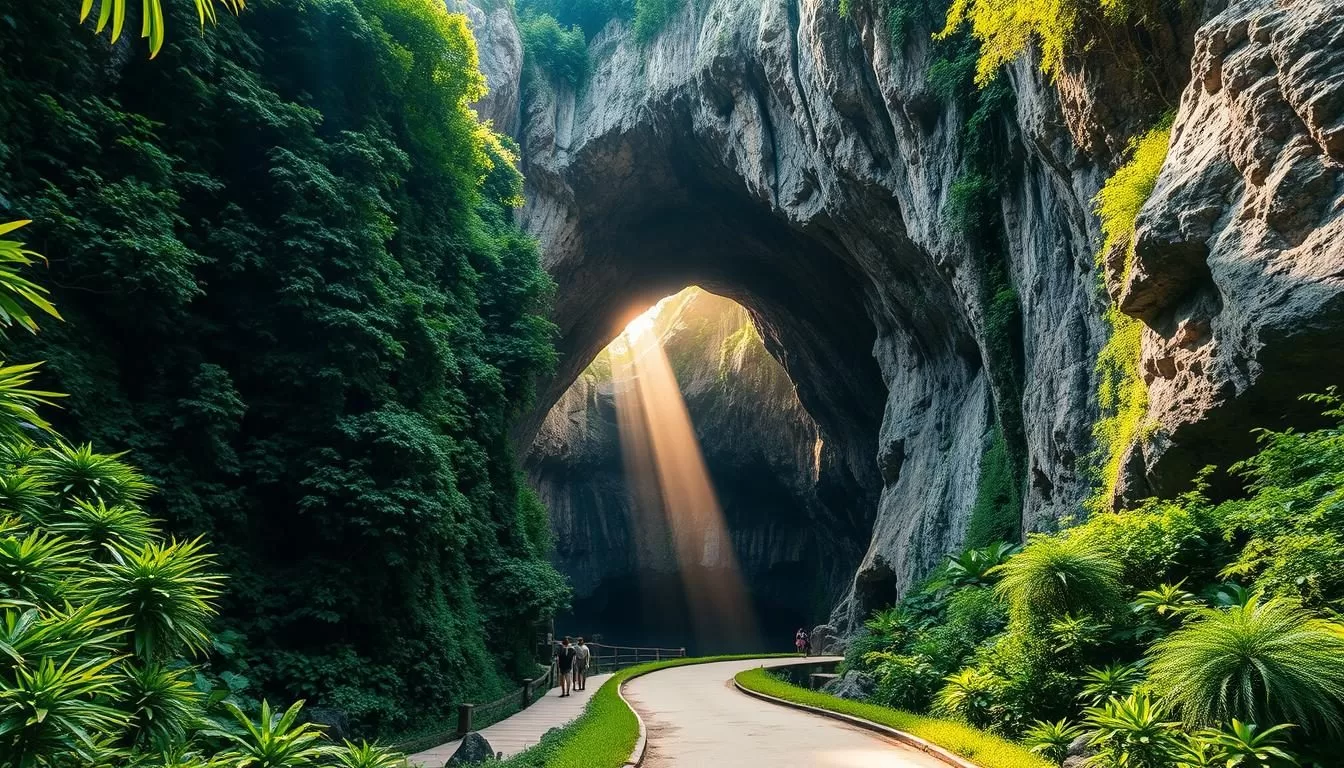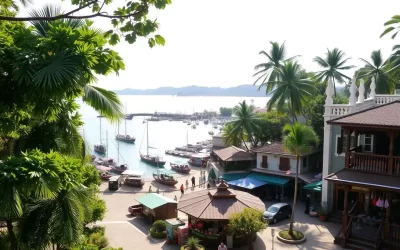✓ Accommodations✓ Flights✓ Rental Cars
Imagine stepping into a site that holds the secrets of human history dating back 40,000 years. Located in Malaysia, Niah Caves are a treasure trove of archaeological wonders, considered the birthplace of civilization in Southeast Asia.
You are about to explore one of Malaysia’s most unique national parks, where the blend of natural beauty and historical significance creates an unforgettable experience. As you venture into this national park, you’ll discover ancient cave paintings, archaeological treasures, and unique geological formations.
This guide will walk you through the best places to visit and things to do, from exploring the impressive Great Cave to witnessing the traditional birds’ nest harvesting industry that continues to this day.
Discovering Niah National Park: An Archaeological Wonder
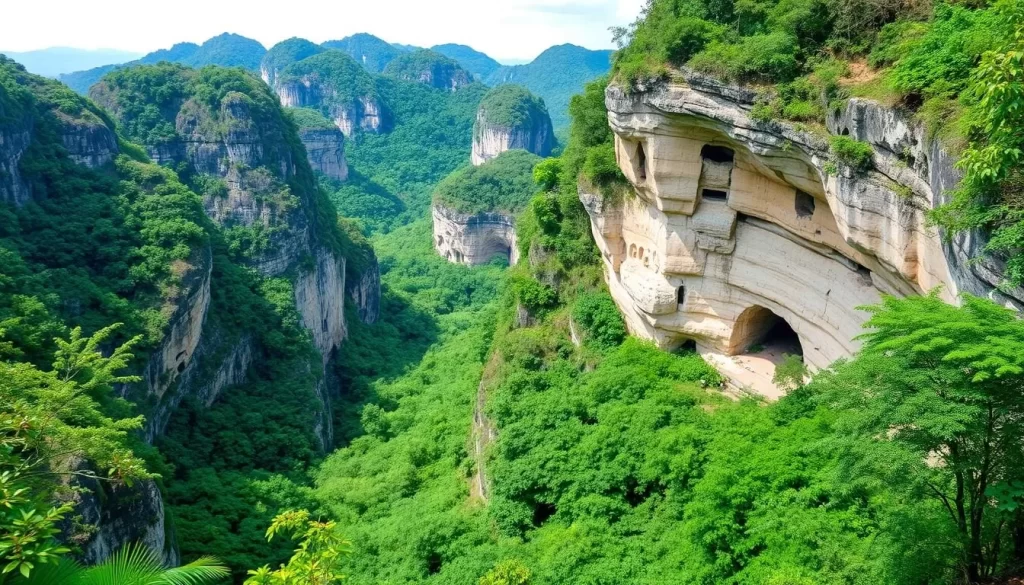
For those seeking a unique adventure, Niah National Park in Malaysia stands out as an archaeological wonder. Unlike many national parks that focus on wildlife and biodiversity, Niah National Park is distinguished by its ancient limestone caves, known as the Niah Caves, which have been the site of human habitation for tens of thousands of years.
Location and Size of the Park
Niah National Park is located within the Miri Division of Sarawak, Malaysia. It covers an area that encompasses the Niah Caves and the surrounding landscape. The park’s strategic location near the coast has made it an important site for human settlement throughout history.
The park’s size is substantial enough to include a variety of landscapes, from the limestone caves to the surrounding rainforest. This diversity in landscape supports a wide range of flora and fauna, making it a unique experience for visitors.
The Park’s Unique Geological Features
The Niah Caves are the park’s most striking feature, with their massive limestone formations. These caves have been shaped over millions of years through geological processes, creating a natural wonder that attracts visitors from around the world.
The caves’ unique geological features include the massive 60-meter high entrance to the Great Cave, which is one of the largest cave entrances in the world. This natural arch is not only an impressive sight but also provides a glimpse into the geological history of the area.
Why Niah Stands Out Among Malaysian National Parks
Niah National Park distinguishes itself from other Malaysian national parks through its archaeological significance. As one of the oldest known human settlement sites in Southeast Asia, it offers a rare opportunity to walk in the footsteps of ancient humans.
The park’s blend of natural beauty and historical significance makes it one of the best places to experience Malaysia’s rich cultural heritage. Unlike more commercialized tourist destinations, Niah maintains an authentic atmosphere, allowing for genuine exploration and discovery.
Visiting Niah National Park is an experience that connects you directly with human prehistory, making it a must-visit destination for anyone interested in archaeology or history.
The Historical Significance of Niah Caves
Stepping into Niah Caves, you’re stepping back in time, into a world where early humans once thrived. The historical significance of Niah Caves is multifaceted, with the site being considered the birthplace of civilization in Southeast Asia. It is here that archaeologists have uncovered a treasure trove of artifacts and human remains that have shed light on the lives of our ancient ancestors.
40,000-Year-Old Human Remains
The discovery of 40,000-year-old human remains at Niah Caves is a significant finding that has reshaped our understanding of human history in the region. These ancient remains, known as the “Deep Skull,” were discovered in 1958 by Tom Harrisson, a curator at the Sarawak Museum. The Deep Skull is significant not only because of its age but also due to its implications for understanding human migration patterns and the early history of human settlement in Southeast Asia.
The presence of such ancient human remains indicates that Niah Caves have been a habitable site for tens of thousands of years, making it one of the oldest recorded human settlements in East Malaysia. The fact that these early humans were able to survive and thrive in this environment speaks to their resilience and adaptability.
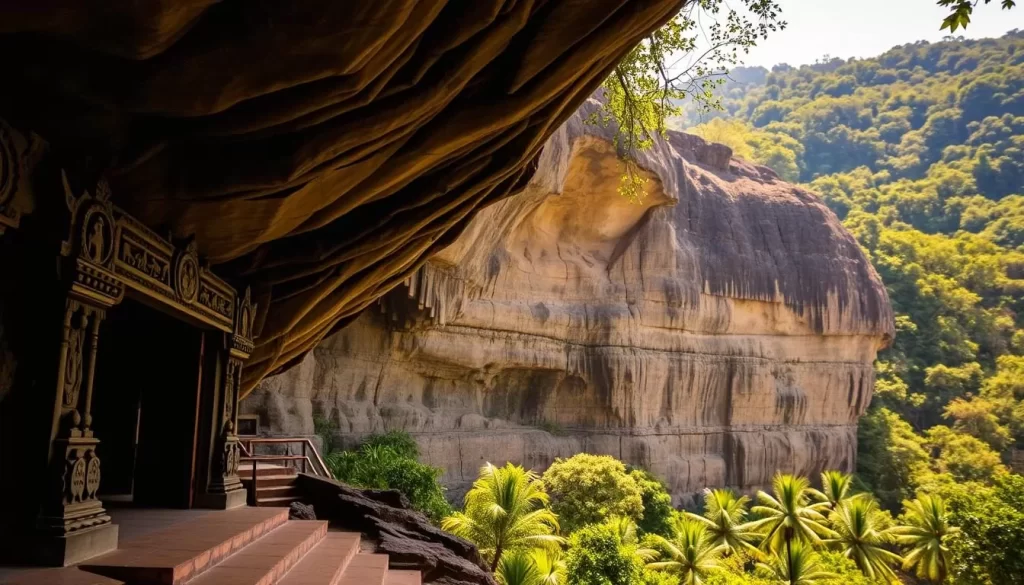
The Birthplace of Southeast Asian Civilization
Niah Caves is often referred to as the “birthplace of civilization in Southeast Asia” due to the evidence of continuous human habitation spanning tens of thousands of years. The archaeological findings suggest that the caves served as home to multiple generations of early people, who developed sophisticated cultural practices over time. Excavations have revealed evidence of evolving human culture, including burial practices, tool-making techniques, and artistic expressions that show the development of human society.
The site provides a unique window into how early humans adapted to their environment and developed the foundations of what would eventually become Southeast Asian civilization. Understanding the significance of Niah helps you appreciate how this remote location played a crucial role in the human story of Southeast Asia, connecting modern visitors with their ancient ancestors.
| Aspect | Description | Significance |
|---|---|---|
| Human Remains | 40,000-year-old Deep Skull | Oldest recorded human settlement in East Malaysia |
| Cultural Practices | Burial practices, tool-making, artistic expressions | Evidence of evolving human culture and societal development |
| Environmental Adaptation | Early humans adapted to the cave environment | Demonstrates human resilience and adaptability |
Exploring the Great Cave: Niah’s Main Attraction

The Great Cave, Niah’s crown jewel, beckons explorers to uncover its secrets. As you venture into this natural wonder, you’ll be struck by its sheer scale and beauty.
The Impressive 60-Meter High Entrance
The Great Cave’s entrance is an awe-inspiring sight, standing 60 meters high and wide enough to fit a large aircraft hangar. This massive opening allows natural light to flood the cave, illuminating the intricate rock formations and creating an otherworldly atmosphere.
As you step inside, the enormity of the cave becomes apparent, and you’re immediately immersed in an experience that combines adventure and natural wonder.
Navigating the Plank Walkways Through the Cave
To facilitate exploration, the cave is equipped with plank walkways that guide visitors through the vast interior. These walkways provide a safe and stable path, allowing you to take in the stunning formations and unique features of the cave without obstruction.
Navigating through the cave on these walkways offers a thrilling adventure, as you discover hidden chambers and marvel at the geological wonders on display.
The Dark Adventure of Moon Cave
Beyond the illuminated sections of the Great Cave lies Moon Cave, a completely dark chamber that offers a more intense experience for visitors willing to venture deeper into the cave system. To navigate through Moon Cave, a good flashlight or headlamp is essential, as there is no natural light to guide you.
The darkness of Moon Cave creates an immersive atmosphere, heightening your senses as you notice the sounds of dripping water, the flutter of bat wings, and the unique cave environment. This is a truly unique place to explore, where the absence of light becomes a sensory adventure in itself.
While it may seem intimidating, Moon Cave is relatively safe to explore, thanks to the continued presence of plank walkways that provide a clear path through the darkness.
The Painted Cave: Ancient Art and Death Ships
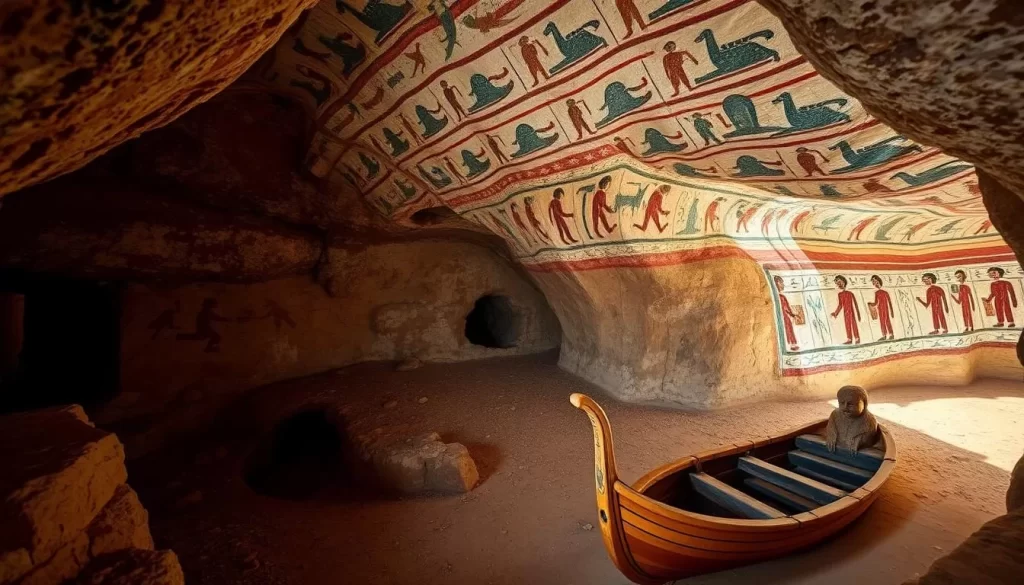
As you venture into the Painted Cave, you’ll uncover a world of ancient wall paintings and intriguing ‘death ships’.
The Painted Cave is a significant site within Niah National Park, known for its ancient wall paintings and unique burial practices. The cave gets its name from the vibrant paintings that adorn its walls, a testament to the artistic and spiritual expression of the people who once inhabited this region.
1,200-Year-Old Wall Paintings
The wall paintings in the Painted Cave are estimated to be around 1,200 years old, providing a glimpse into the lives and beliefs of the ancient communities. These paintings depict various scenes, potentially related to the spiritual and daily life of the people who created them.
The artistry and culture represented by these paintings are significant, as they reflect the complex spiritual beliefs and social structures of the ancient people who used the cave.
Boat-Shaped Coffins and Ancient Burial Sites
One of the most fascinating aspects of the Painted Cave is the presence of “death ships” or boat-shaped coffins. These coffins were used as part of the burial rituals over a thousand years ago, reflecting the belief that the deceased needed transportation to the afterlife. This practice is a notable aspect of the culture and spiritual beliefs of the ancient people.
Archaeological excavations have revealed that the burial site contained not just the coffins but also grave goods like pottery, tools, and personal ornaments meant to accompany the deceased. The presence of these elaborate burial practices indicates that the people had developed complex spiritual beliefs and social structures by this time.
While the original coffins have been moved to museums for preservation, replicas and informational displays at the cave help visitors understand the significance of this ancient burial site and the cultural practices it represents.
Gan Kira Cave: Archaeological Treasures
As you explore Gan Kira Cave, you will discover a wealth of archaeological treasures that provide insights into the lives of ancient people. This cave has been a significant site for archaeological explorations, yielding a vast array of artifacts that have helped researchers understand the cultural, social, and economic dynamics of the Neolithic period.
The Harrison Explorations of 1959
The year 1959 marked a significant milestone in the history of Gan Kira Cave with the Harrison Explorations. Led by Tom Harrison, this expedition uncovered a multitude of artifacts that shed light on the lives of the people who lived thousands of years ago. The explorations included excavations that revealed Neolithic burial sites, pottery, and ornaments, among other findings.
These discoveries were crucial in understanding the lifestyle and cultural practices of the Neolithic people. The artifacts found during this expedition have been instrumental in reconstructing the history of human occupation in the cave over thousands of years.
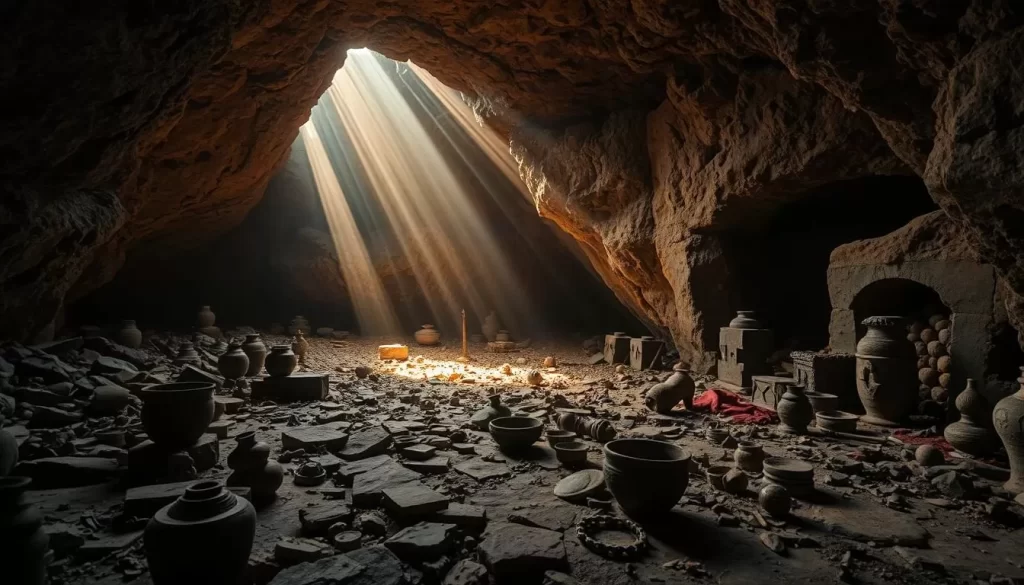
Neolithic Artifacts and What They Tell Us
The Neolithic artifacts discovered in Gan Kira Cave include pottery fragments, stone tools, ornaments, and evidence of burial practices. These artifacts provide valuable insights into how people lived during the Neolithic period, revealing details about their diet, technology, social structure, and artistic expressions.
- The pottery fragments found in the cave show sophisticated craftsmanship, suggesting that the inhabitants had developed specialized skills and possibly traded with other communities over time.
- Personal ornaments such as beads and pendants indicate that these ancient people valued aesthetic expression and possibly used decorative items to signify social status or group identity in various places.
- By studying these artifacts in context, archaeologists have been able to reconstruct a timeline of human occupation in these caves, showing how people adapted to their environment and developed more complex societies.
The study of these artifacts has been pivotal in understanding the cultural evolution and social dynamics of the Neolithic people. It has given us a glimpse into their daily lives, their beliefs, and their interactions with the environment and other communities.
The Swiftlet Industry: Birds’ Nest Harvesting
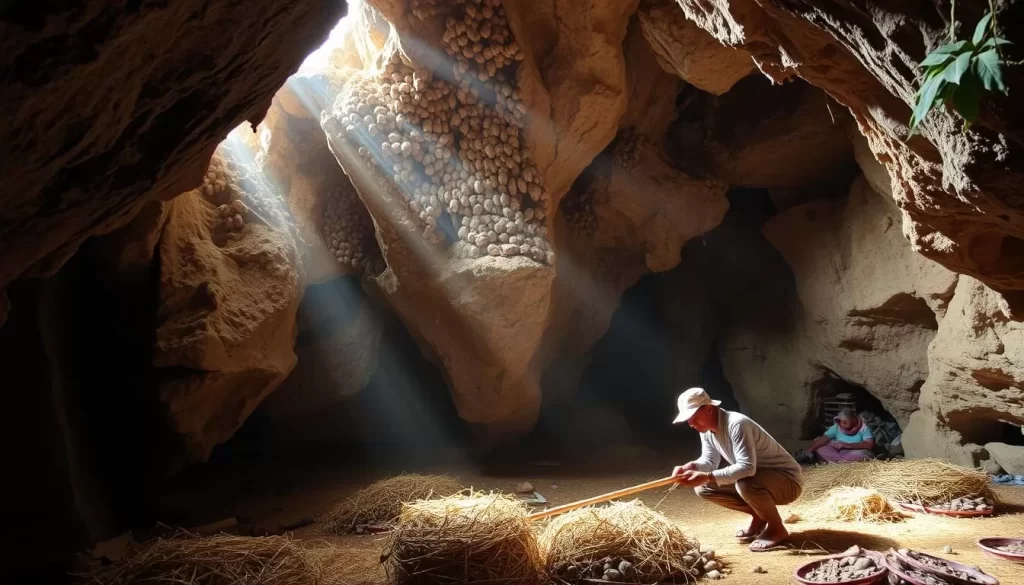
The swiftlet industry in Niah National Park represents a fascinating blend of traditional practices and modern commercial enterprise. For many years, the caves have been a source of edible birds’ nests, highly prized for their culinary and medicinal value, particularly in Chinese culture.
The industry has seen significant growth, becoming a booming sector that contributes substantially to the local economy. Local communities around Niah National Park have been involved in the birds’ nest harvesting for generations, developing unique techniques passed down through the years.
Traditional Harvesting Techniques
The harvesting of swiftlet nests is done with great care and precision, adhering to traditional methods that ensure sustainability. Harvesters, often from local families who have been granted harvesting rights, venture into the caves under the cover of darkness to collect the nests. This traditional practice not only provides a source of income but also preserves cultural heritage.
The industry has evolved significantly over time, incorporating modern practices while respecting traditional knowledge. The nests are carefully cleaned, graded, and packaged for export, primarily to markets in China and other parts of Asia where they are considered a delicacy.
Economic Importance to Local Communities
The birds’ nest industry is a vital economic resource for the locals and people living around Niah National Park. The high-quality nests fetch premium prices in international markets, creating a sustainable income source for many families. Beyond the harvesting itself, the industry generates additional employment opportunities in processing, cleaning, and packaging the nests for export.
The economic benefits of the swiftlet industry have also led to increased conservation efforts for both the caves and the swiftlet populations. This demonstrates how traditional practices can align with modern conservation goals when properly managed, ensuring the long-term sustainability of this unique industry.
Niah National Park, Malaysia: Best Things to Do – Top Picks
When planning your trip to Niah National Park, you’ll find a variety of experiences to suit your interests. The park is not just about the caves; it’s an immersive nature experience that encompasses jungle trekking, wildlife observation, and serene river cruises.
Self-Guided Cave Exploration
One of the main attractions of Niah National Park is the self-guided exploration of its caves. The Great Cave, with its 60-meter high entrance, is an awe-inspiring sight. As you navigate through the cave via plank walkways, you’ll be surrounded by the sounds of swiftlets and bats. The experience is both exhilarating and humbling, given the cave’s historical significance.
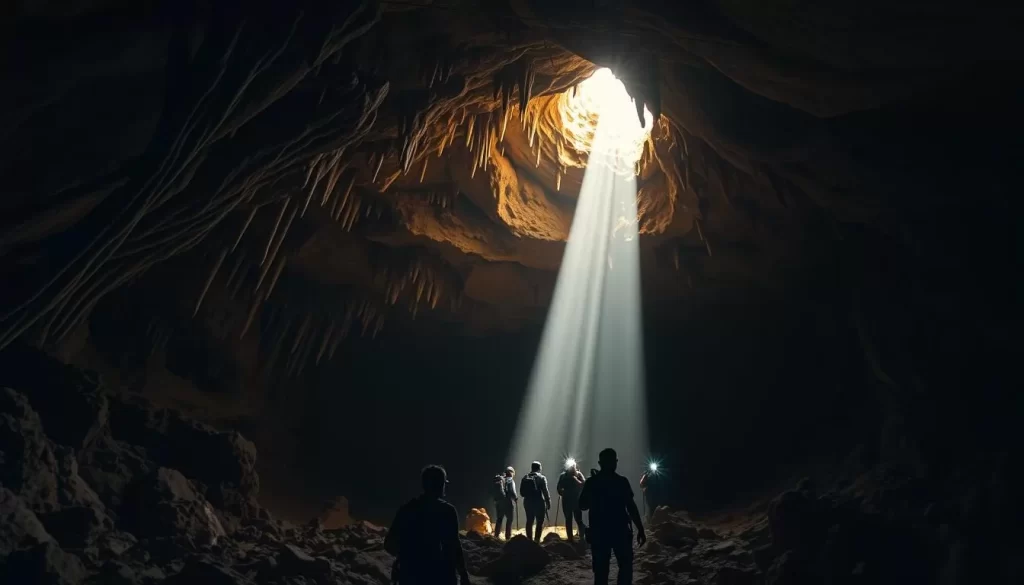
Jungle Trekking and Nature Photography
For those who enjoy jungle trekking, Niah National Park offers trails that wind through the lush rainforest. This activity allows you to experience the park’s biodiversity firsthand. Nature photography enthusiasts will find ample opportunities to capture the vibrant flora and fauna of the region.
Wildlife Observation Opportunities
The park is a haven for wildlife enthusiasts. From the various bird species to monitor lizards and the occasional crocodile, there’s a rich array of wildlife to observe. The park’s diverse ecosystems support a wide range of species, making it a fascinating place for observation and learning.
River Cruises Near the Park
After exploring the caves, a river cruise offers a relaxing and different perspective on the region. The nearby rivers provide a serene environment where you can observe riverine wildlife in their natural habitat. Local operators offer cruises that range from one-hour trips to half-day excursions, some of which include visits to riverside villages or fishing demonstrations.
Adding a river cruise to your visit creates a more rounded experience of Sarawak’s natural environments. It’s a pleasant way to unwind after the physical exertion of cave exploration. The experience is further enhanced by the peaceful atmosphere and the opportunity to see the region’s landscape from a new angle.
Visiting the Niah Archaeology Museum
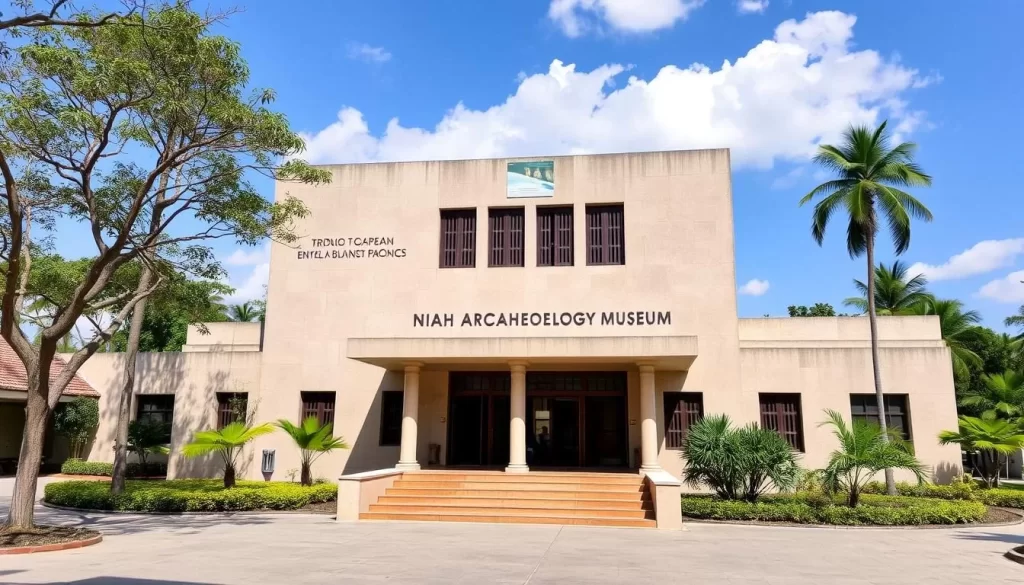
The Niah Archaeology Museum, located near the park headquarters, offers a fascinating glimpse into the geological, ecological, and archaeological wonders of Niah National Park. As you step into the museum, you are greeted by a wealth of information that enhances your understanding of the park’s unique features.
The Deep Skull and Human Remains Collection
One of the museum’s most significant attractions is the Deep Skull and Human Remains Collection. This exhibit showcases human remains that date back thousands of years, providing valuable insights into the lives of the earliest inhabitants of the region. The Deep Skull, a significant archaeological find, is a highlight of the collection, offering a glimpse into the region’s ancient past.
The collection is meticulously curated, with each artifact carefully preserved and displayed to educate visitors about the history and significance of the human remains found in the Niah Caves.
Prehistoric Tools and Pottery Displays
The museum also features an impressive array of prehistoric tools and pottery, which were discovered during excavations in the Niah Caves. These artifacts provide a window into the lives of the people who once inhabited the area, showcasing their technological advancements and cultural practices.
Visitors can observe the intricate details of these ancient tools and pottery, gaining a deeper appreciation for the resourcefulness and creativity of the region’s early inhabitants.
Interactive Exhibits on Niah’s Geology and Ecology
In addition to its archaeological exhibits, the Niah Archaeology Museum offers interactive displays that explain the geological processes that formed the limestone caves over millions of years. These exhibits serve as an excellent guide to understanding the natural forces that created the unique environment of Niah National Park.
The ecology section of the museum highlights the specialized plants and animals that have adapted to life in and around the caves, from the swiftlets that build valuable nests to the unique insects that thrive in the dark cave environment. This serves as a great introduction to the nature and biodiversity of the area.
Hiking Trails in Niah National Park
Niah National Park’s hiking trails offer a unique opportunity to explore the park’s natural wonders up close. As you venture into the rainforest, you’ll be surrounded by the sights and sounds of a diverse ecosystem.
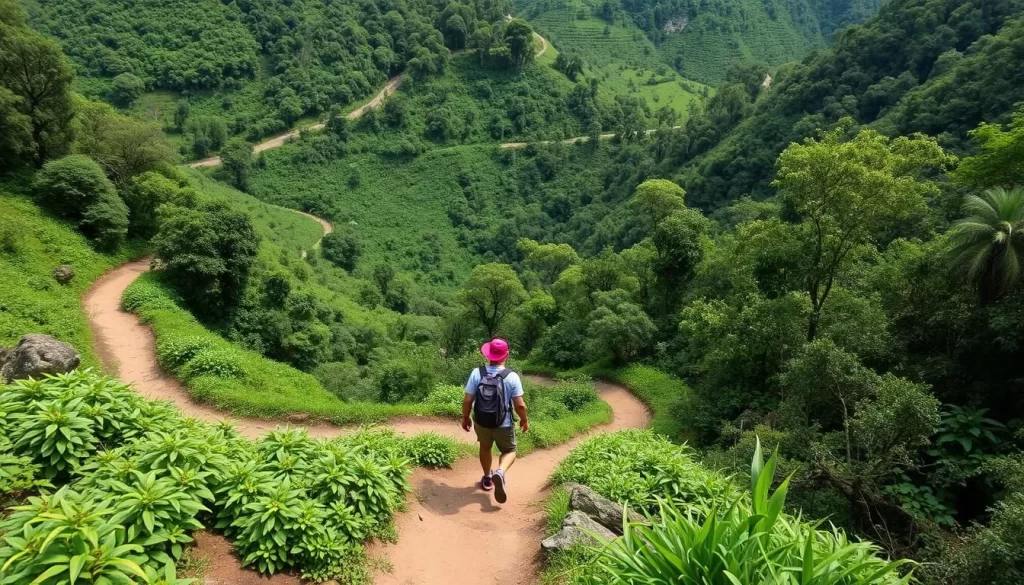
The Main 3.5 km Trail to the Caves
The main trail to the caves is a 3.5 km journey that takes you through the heart of the rainforest. This trail is well-marked and provides a great introduction to the park’s flora and fauna.
As you walk, you’ll notice the towering trees, some of which are over 40 meters tall, and the variety of plants that thrive in this environment, including wild orchids and pitcher plants.
Lesser-Known Paths and Nature Walks
Beyond the main trail, Niah National Park offers several lesser-known paths and nature walks that allow for a more immersive experience. These trails wind through the forest, providing opportunities to spot colorful birds and small mammals.
Keep an eye out for the park’s diverse wildlife, including long-tailed macaques and the occasional gibbon swinging through the canopy.
Flora and Fauna to Spot Along the Way
The trails of Niah National Park are home to a vast array of flora and fauna. As you hike, you’ll have the chance to spot various species that are native to Borneo, including monitor lizards and snake species.
A good field guide to Borneo’s wildlife will enhance your experience, helping you identify the many species you’ll encounter and understand their ecological roles in this complex rainforest ecosystem.
Some of the key species to look out for include:
- The trails of Niah National Park wind through diverse ecosystems where attentive visitors can spot an impressive variety of flora and fauna native to Borneo.
- Keep your eyes peeled for colorful birds like hornbills and kingfishers, as well as various primates including long-tailed macaques and the occasional gibbon swinging through the canopy.
- The undergrowth hosts a wealth of fascinating plants, including wild orchids, pitcher plants, and giant ferns that thrive in the humid rainforest environment.
- Reptiles such as monitor lizards and various snake species can sometimes be spotted sunning themselves along the trails or near water sources.
- A good field guide to Borneo’s wildlife will enhance your experience, helping you identify the many species you’ll encounter and understand their ecological roles in this complex rainforest ecosystem.
Best Time to Visit Niah National Park
To make the most of your visit to Niah National Park, understanding the seasonal variations is key. The park’s unique features and attractions can be fully appreciated during the right time of the year, ensuring a safe and enjoyable experience.
March to Early November: The Ideal Season
The period from March to early November is considered the ideal time to visit Niah National Park. During these months, the weather is generally dry and conducive to outdoor activities such as jungle trekking and cave exploration. The trails are more accessible, and the risk of disruptions due to weather conditions is minimal, allowing for a smoother and more enjoyable trip.
Advantages of Visiting During This Time:
- The dry weather ensures that the trails are less muddy and slippery, reducing the risk of accidents.
- The plank walkways within the caves are less likely to be closed due to flooding, providing uninterrupted access to the park’s main attractions.
- The dry conditions enhance visibility and make photography more rewarding, capturing the beauty of the caves and their surroundings.
Avoiding the Monsoon Season (November to February)
The monsoon season, which starts from mid-November and lasts until late February, brings heavy rainfall to Sarawak, making this period challenging for visiting Niah National Park. The trails can become extremely muddy and slippery, and some sections of the plank walkways may be temporarily closed due to flooding or safety concerns.
- The boat crossing of the Niah River, part of the approach to the caves, can sometimes be suspended during heavy rains when the river is swollen and fast-flowing.
- Visitors may need to plan for flexibility in their schedule, as navigating the trails or facing delays due to weather conditions can take extra time.
- While the caves offer shelter from rain, the reduced visibility and increased humidity during this season can diminish the overall experience and make photography more challenging.
By choosing to visit Niah National Park between March and early November, you can ensure a more enjoyable and stress-free trip, taking full advantage of the park’s natural beauty and archaeological significance.
How to Get to Niah National Park
You can easily drive or take public transport to Niah National Park from Miri, making it an ideal day trip or longer stay.
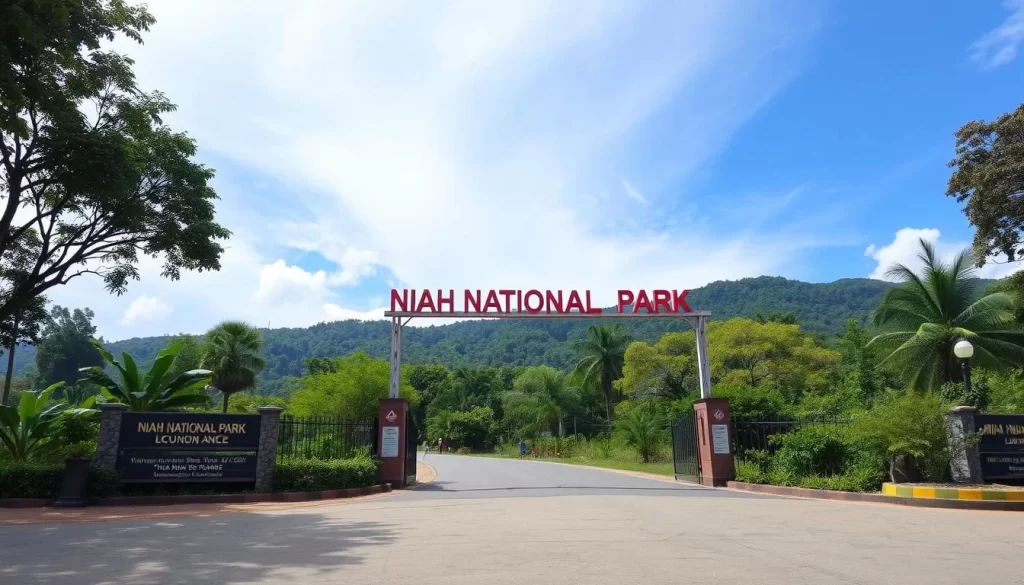
From Miri City by Taxi (90 km Journey)
One of the most convenient ways to reach Niah National Park from Miri city is by taxi. The journey covers approximately 90 km and takes about an hour and a half, depending on traffic conditions. You can hire a taxi from Miri city for a day trip or for the duration of your stay.
The cost of a taxi trip can vary, but it is generally around RM150-RM200 (Malaysian Ringgit) for a one-way trip. It’s advisable to negotiate the fare before you start your journey.
Public Bus Options via Pujut Corner Bus Terminal
For a more budget-friendly option, you can take a public bus from Miri’s Pujut Corner Bus Terminal. Buses operate regularly to Niah, and the journey takes about two hours. The bus will drop you off at the Niah Junction, from where you can take a short taxi ride or walk to the park headquarters.
The bus fare is relatively inexpensive, around RM5-RM10 per person, making it an economical choice for travelers.
Self-Drive Directions and Parking Information
Renting a car and driving yourself to Niah National Park gives you maximum flexibility for your trip and is relatively straightforward if you’re comfortable driving in Malaysia. From Miri city, follow the Pan Borneo Highway (Federal Route 1) southbound for approximately 80 kilometers until you reach the well-signed turnoff for Niah National Park.
After turning off the highway, continue for about 10 kilometers on a smaller road that leads directly to the park headquarters and visitor center. Parking is available at the park headquarters for a nominal fee (around RM5), with plenty of spaces usually available except during peak holiday periods.
The self-drive option allows you to stop at interesting points along the way, including the scenic Tusan Beach, which makes for a perfect side trip when combined with your Niah visit.
It’s also worth noting that it is easy to reach the Park headquarters from Batu, which is just a 3-kilometer distance, offering another travel option to consider for your trip.
Entry Fees and Opening Hours
Visiting Niah National Park requires some planning, especially when it comes to understanding the entry fees and operating hours. To ensure a smooth and enjoyable visit, it’s crucial to be aware of these details beforehand.
Ticket Prices for Locals and Foreigners
Niah National Park has a straightforward ticketing system with different rates for locals and foreigners. The park authorities have structured the fees to be inclusive, allowing visitors to explore the rich cultural and natural heritage within the park. It’s worth noting that the fees contribute to the conservation efforts and maintenance of the park’s facilities.
Ticket prices are as follows:
- Locals: A nominal fee that encourages domestic tourism and supports local community engagement.
- Foreigners: A slightly higher fee that reflects the international appeal of the park and contributes to its upkeep.
The exact prices may vary, so it’s a good idea to check the latest information before your visit.
Park Operating Hours and Best Times to Enter
Niah National Park operates daily from 8:00 AM to 5:00 PM, with the last entry to the caves typically allowed around 3:00 PM. This timing ensures that visitors have enough time to explore the caves and return before dark. Planning your visit according to these hours is essential for a fulfilling experience.
The best time to enter the park is early in the morning, ideally right when it opens at 8:00 AM. This timing allows you to maximize your exploration time and avoid the midday heat. Additionally, an early start increases your chances of spotting wildlife along the trails and gives you the caves mostly to yourself before tour groups arrive later in the morning.
If you’re particularly interested in photographing the caves, mid-morning (around 10:00 AM) offers good lighting conditions as sunlight penetrates certain sections of the Great Cave. It’s recommended to plan to spend at least 3-4 hours in the park to comfortably explore the main caves and surrounding trails.
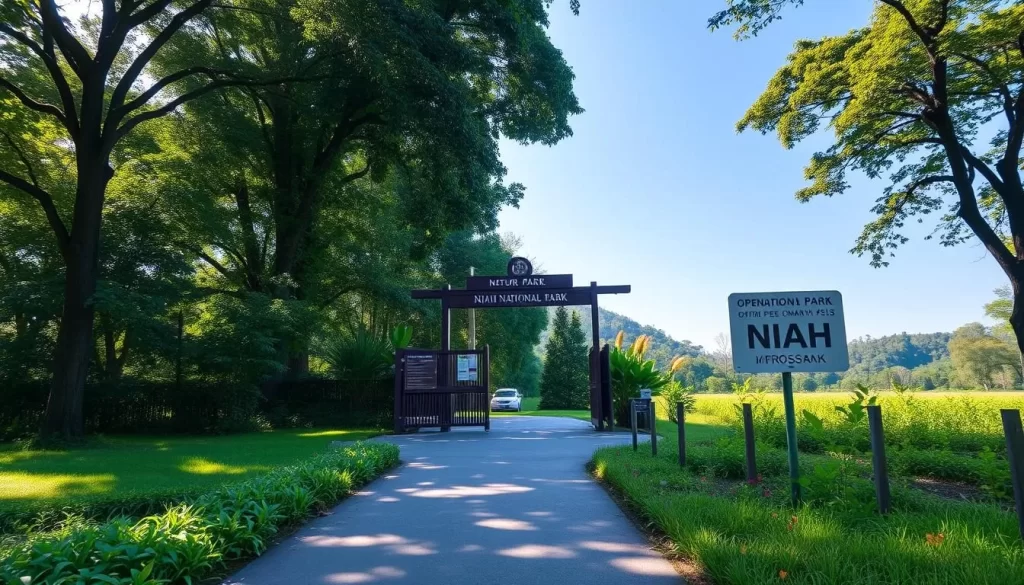
By understanding the entry fees and operating hours, you can better plan your visit to Niah National Park, ensuring a memorable and enriching experience.
Accommodation Options Near Niah National Park

The accommodations near Niah National Park cater to a range of preferences and budgets. Whether you’re looking for a cozy chalet, a hostel-style room, or a camping experience under the stars, Niah National Park has something for you.
Park Chalets and Hostel-Style Rooms
For those who prefer a roof over their heads, Niah National Park offers chalet units and hostel-style rooms. These accommodations provide a comfortable stay with basic amenities, allowing you to rest easy after a day of exploring the park’s vast caves and lush surroundings.
The chalets are designed to accommodate families and groups, while the hostel-style rooms are ideal for solo travelers or those on a tighter budget.
Nearby Hotels: Samalaju Resort, Niah Cave Inn, and Others
If you prefer to stay outside the park, there are several hotels and inns in the nearby area. The Samalaju Resort and Niah Cave Inn are popular choices, offering comfortable accommodations and easy access to the park.
These hotels often provide additional amenities such as restaurants, swimming pools, and guided tour services, enhancing your overall experience.
Camping Facilities and What to Bring
For the more adventurous, Niah National Park’s designated camping facilities offer a chance to immerse yourself in nature. The facilities are equipped with basic amenities like toilets, showers, and cooking facilities. However, you’ll need to bring your own camping gear.
Essential items to bring include a sturdy tent with a rainfly, sleeping mat, sleeping bag, insect repellent, and a flashlight or headlamp. Camping at Niah National Park allows you to experience the forest’s nocturnal sounds and potentially spot wildlife.
Remember to secure your food and trash to avoid attracting wildlife, such as monkeys, to your campsite.
When visiting Niah National park, choosing the right accommodation can enhance your experience. From the tranquility of the chalets to the adventure of camping, there’s something for every kind of traveler.
Day Trip from Miri: Combining Niah Caves with Tusan Beach
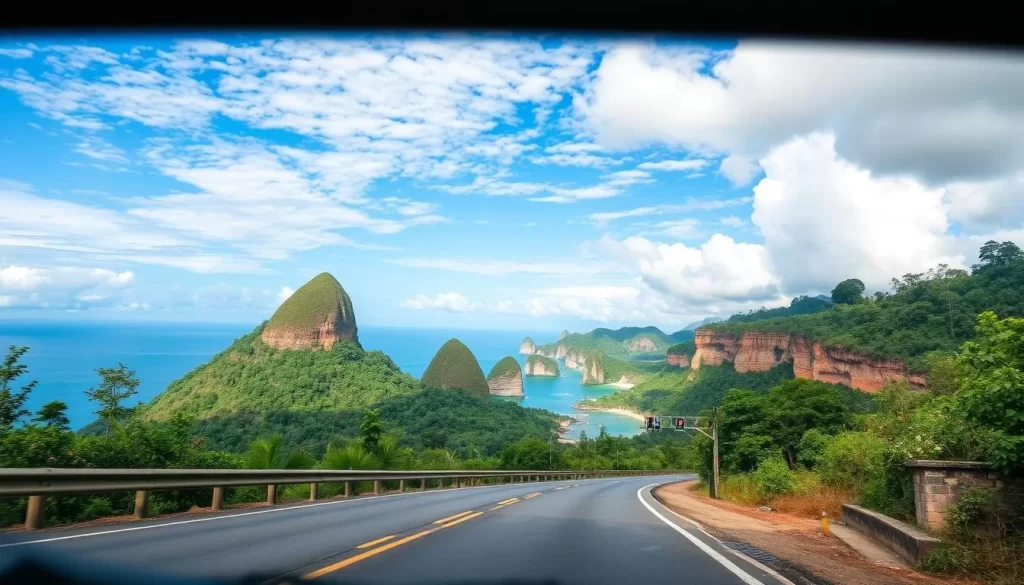
A day trip from Miri to Niah Caves and Tusan Beach offers an unforgettable experience, allowing you to explore the natural and archaeological wonders of Malaysia.
Planning Your Itinerary and Transportation
To make the most of your day trip, planning is essential. The journey from Miri to Niah Caves takes about an hour and a half by car. You can either rent a car or hire a taxi for the day. Once you’ve explored the caves, head to Tusan Beach, which is approximately a 45-minute drive away.
When planning your itinerary, consider the opening hours of Niah Caves and the time needed to explore both attractions. It’s advisable to start early to avoid the heat and make the most of your day.
Tusan Beach: White Sands and the Blue Tears Phenomenon
Tusan Beach is a hidden gem, known for its pristine white sands and crystal-clear waters. To access the beach, you’ll need to hike down some steep rocks, but the effort is well worth it. The beach is relatively undeveloped, ensuring a serene and peaceful experience.
One of the main attractions of Tusan Beach is the “Blue Tears” phenomenon. This natural occurrence happens when bioluminescent plankton surface in the water, causing it to glow blue at night. The phenomenon is best observed during certain weather conditions and between March and September.
Even without the Blue Tears, Tusan Beach offers stunning sunset views and a chance to relax in a secluded environment. It’s the perfect conclusion to a day of exploring Niah Caves.
As you visit Tusan Beach, take a moment to appreciate the dramatic cliff formations and the clear waters of the South China Sea. The experience is truly unforgettable, with the beach offering a striking contrast to the cave environment of Niah.
The beach is a great place to unwind, with its sugar-like sand and pristine water. If you’re lucky, you might even witness the phenomenon of the Blue Tears, making your day trip even more memorable.
Essential Tips for Visiting Niah National Park
Exploring Niah National Park is an exciting journey that begins with understanding what to expect and how to prepare. As you plan your visit, it’s essential to consider several factors that will enhance your experience in this unique environment.
What to Pack: Torch, Hat, and Proper Footwear
When preparing for your visit to Niah National Park, packing the right gear is crucial. A reliable torch (or flashlight) is a must-have for navigating the dark passages within the caves. Additionally, wearing a hat and applying sunscreen will protect you from the sun’s strong rays during your outdoor explorations. Proper footwear is also essential; sturdy, comfortable shoes with good grip will help you navigate the often uneven and slippery paths.
Comfortable clothing suitable for tropical weather conditions is also recommended. The humidity and temperature inside the caves are relatively stable, but the outside environment can be hot and humid. Bringing a light rain jacket is advisable, as sudden rain showers are common.
Dealing with Wildlife: Swiftlets, Bats, and Insects
Niah National Park is home to a diverse range of wildlife, including swiftlets, bats, and various insects. While these creatures are an integral part of the park’s ecosystem, visitors should be aware of how to coexist with them peacefully. For instance, the swiftlets and bats are sensitive to light and noise, so it’s recommended to minimize flash photography and loud noises when inside the caves to avoid disturbing them.
Insect repellent is also a useful item to pack, as mosquitoes and other insects can be present. However, it’s worth noting that the park’s management implements measures to control the insect population, ensuring a relatively comfortable visit.
Photography Challenges in Cave Environments
Photographing inside Niah’s caves presents unique challenges due to the extreme contrast between the bright entrance areas and the dark interior sections. For best results, visit during mid-morning when sunlight penetrates deeper into the Great Cave, creating dramatic light beams that can make for spectacular photographs.
A camera with good low-light performance and manual settings is highly recommended, as automatic modes often struggle with the cave’s challenging lighting conditions. Consider bringing a small tripod for longer exposures in darker areas, though be mindful of where you set it up to avoid blocking the walkway for other visitors.
| Photography Tip | Description | Benefit |
|---|---|---|
| Use a camera with good low-light performance | Allows for better image quality in dark environments | Captures details in cave interiors |
| Bring a small tripod | Enables longer exposure shots without camera shake | Improves image clarity in low light |
| Visit during mid-morning | Takes advantage of natural light penetration into the caves | Creates dramatic lighting effects |
By understanding these challenges and tips, you can better prepare yourself for capturing the beauty of Niah National Park, making your visit even more memorable.
Conclusion
Niah National Park is more than just a visit; it’s an immersive journey through time, nature, and culture. As you explore this remarkable destination, you’ll discover that it’s among the top picks for any trip to Malaysia.
The park offers a unique blend of archaeological significance, natural beauty, and cultural heritage. From the awe-inspiring Great Cave with its 40,000-year history of human habitation to the mysterious Painted Cave with its ancient art, Niah provides a journey through time that few other places in Southeast Asia can match.
Beyond the caves, the surrounding rainforest, wildlife viewing opportunities, and nearby attractions like Tusan Beach create a well-rounded experience. Whether you’re a history buff, nature lover, or adventure seeker, Niah National Park is one of the best things to do in Sarawak. It’s a place where humans have found shelter, sustenance, and spiritual meaning for tens of thousands of years, making it a truly special destination.
As you plan your visit to Niah National Park, remember to take your time to absorb the atmosphere and connect with our shared human past.
The above is subject to change.
Check back often to TRAVEL.COM for the latest travel tips and deals.
